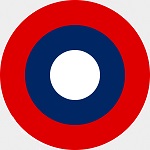Wings of the Great War WW11101 U.S. Marine Corps Airco DH4 Bomber - Squadron D, France, 1918 (1:72 Scale)
"Aviation is proof that given, the will, we have the capacity to achieve the impossible."
- Eddie Rickenbacker
 The Airco DH.4 was a British two-seat biplane day-bomber of the First World War. It was designed by Geoffrey de Havilland (hence "DH") for Airco, and was the first British two seat light day-bomber to have an effective defensive armament. It first flew in August 1916 and entered service with the Royal Flying Corps (RFC) in March 1917. The majority of DH.4s were actually built as general purpose two-seaters in the USA, for service with the American forces in France.
The Airco DH.4 was a British two-seat biplane day-bomber of the First World War. It was designed by Geoffrey de Havilland (hence "DH") for Airco, and was the first British two seat light day-bomber to have an effective defensive armament. It first flew in August 1916 and entered service with the Royal Flying Corps (RFC) in March 1917. The majority of DH.4s were actually built as general purpose two-seaters in the USA, for service with the American forces in France.
The DH.4 was tried with several engines, of which the best was the 375 hp (280 kW) Rolls-Royce Eagle engine. Armament and ordnance for the aircraft consisted of one 0.303 in (7.7 mm) Vickers machine gun for the pilot and one 0.303 in (7.7 mm) Lewis gun on a Scarff ring mounting for the observer. Two 230 lb (100 kg) bombs or four 112 lb (51 kg) bombs could be carried. The DH.4 entered service on 6 March 1917 with No. 55 Squadron in France.
Pictured here is a 1:72 scale replica of a U.S. Marine Corps Airco DH4 bomber that was attached to the USMC's Squadron D, then deployed to France during 1918.
Sold Out!
Dimensions:
Length: 4-1/4-inches
Wingspan: 6-1/2-inches
Release Date: December 2015
Historical Account: "Billion Dollar Bonfire" - At the time of its entry into the war, the United States Army Air Service lacked any aircraft suitable for front line combat. It therefore procured various aircraft from the British and French, one being the DH.4. As the DH-4, it was manufactured mostly by Dayton-Wright and Fisher Body for service with the United States from 1918, the first American built DH-4 being delivered to France in May 1918, with combat operations commencing in August 1918. The powerplant was a Liberty L-12 of 400 hp (300 kW) and it was fitted with two .30 in (7.62 mm) Marlin machine guns in the nose and two .30 in (7.62 mm) Lewis guns in the rear and could carry 322 lb (146 kg) of bombs. it could also be equipped with various radios like the SCR-68 for artillery spotting missions. The heavier engine reduced performance compared with the Rolls-Royce powered version, but as the "Liberty Plane" it became the US Army Air Service standard general purpose two-seater, and on the whole was fairly popular with its crews.
Aircrew operating the DH-4 were awarded four of the six Medals of Honor awarded to American aviators. First Lieutenant Harold Ernest Goettler and Second Lieutenant Erwin R. Bleckley received posthumous awards after being killed on October 12th, 1918, attempting to drop supplies to the Lost Battalion of the 77th Division, cut off by German troops during the Meuse-Argonne Offensive; while Second Lieutenant Ralph Talbot and Gunnery Sergeant Robert G. Robinson of the United States Marine Corps (USMC) were awarded the Medal of Honor for beating off attacks from 12 German fighters during a bombing raid over Belgium on October 8th, 1918. The type flew with 13 U.S. squadrons by the end of 1918.
Following the end of World War I, America had a large surplus of DH-4s, with the improved DH-4B becoming available, although none had been shipped to France. It was therefore decided that there was no point in returning aircraft across the Atlantic, so those remaining in France, together with other obsolete observation and trainer aircraft, were burned in what became known as the "Billion Dollar Bonfire". With limited funds available to develop and purchase replacements, the remaining DH-4s formed a major part of American air strength for several years, used for many roles, with as many as 60 variants produced. DH-4s were also widely used for experimental flying, being used as engine testbeds and fitted with new wings. They were used for the first trials of air-to-air refueling on June 25th, 1923, and one carried out an endurance flight of 37 hours, 15 minutes on August 27th-28th, being refueled 16 times and setting 16 new world records for distance, speed and duration. The DH-4 remained in service with the United States Army Air Corps, successor to the United States Army Air Service, until 1932.
DH-4s were also used by the United States Navy and United States Marine Corps, both during World War I and postwar. The Navy and Marine Corps received 51 DH-4s during World War I, followed by 172 DH-4B and DH-4B-1 aircraft postwar and 30 DH-4M-1s with welded steel-tube fuselages (redesignated O2B) in 1925. They remained in service with the Marine Corps until 1929, being used against rebel factions in Nicaragua in 1927, carrying out the first dive-bombing attacks made by U.S. military forces. The U.S. Navy converted some DH-4M-1s into primitive air ambulances that could carry one stretcher casualty in an enclosed area behind the pilot.








![USAF Lockheed-Martin F-35A Lightning II Joint Strike Fighter - 58th Fighter Squadron "Gorillas", 33rd Fighter Wing, July 2011 [Low-Vis Scheme] (1:72 Scale)](http://cdn4.volusion.store/qh9e9-jdqv9/v/vspfiles/photos/HA4407-1.jpg?v-cache=1740197136)
